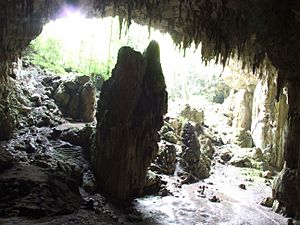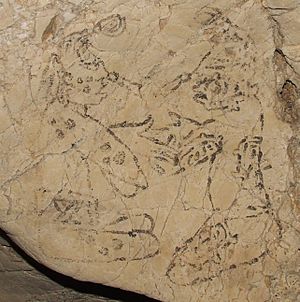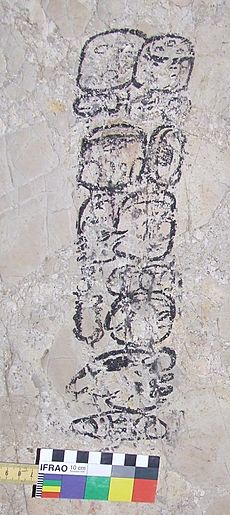Naj Tunich facts for kids
Quick facts for kids Naj Tunich Cave |
|
|---|---|

A wall drawing of a man in rare 3/4 profile
|
|
| Location | Poptún, Guatemala |
| Discovery | 1979 |
| Geology | Karst |
Naj Tunich is a famous natural cave system in Guatemala. Its name means "stone house" or "cave" in the Mopan Maya language. For the ancient Maya people, it was a very important place for special ceremonies and journeys. They used it mostly during the Classic period, from about 600 to 900 AD.
The cave is well-known for its ancient writings, called hieroglyphs. It also has many painted pictures of people, animals, and gods. In 2012, the caves were added to a list of places that might become a UNESCO World Heritage Site. This means they are considered very important globally.
Contents
How Naj Tunich Was Found Again
The Naj Tunich caves were found again in 1979. A local hunter named Bernabé Poin, who was a Q'eqchi' Maya Native, discovered them. He was hunting peccary (a type of wild pig) with his dogs. Bernabé and his father explored the cave. They then told an American named Mike Devine about it.
Later, experts started to study the cave. The first official visit was in 1980. In 1981, teams from the National Geographic Society began exploring. They made detailed maps and took many photos. This was done to help protect the amazing paintings and hieroglyphs inside.
A special book about the cave's art was published in 1988. It was called Images from the Underworld: Naj Tunich and the Tradition of Maya Cave Painting. This book included many photos and drawings of the cave's artwork.
Sadly, the cave was damaged by people several times. Because of this, the caves were closed to the public. However, copies of the cave's paintings were made in a special replica cave. Visitors can now tour this copy to see what the original cave looked like.
Exploring the Cave's Features
Naj Tunich is located on a steep limestone cliff. This makes it quite hard to reach. The entrance to the cave is at the end of a deep valley. Even though it was difficult to get to, the Maya people changed the cave a lot. They built steps, walls, and even filled in parts of the cave floor. They carefully chose and carried materials from far away for these changes.
The cave has two main rooms, called Chamber 1 and Chamber 2. The entrance to Naj Tunich is big enough for natural light to enter Chamber 1. The cave is about 19 meters long and 2.5 meters wide at its widest point. Some parts of the tunnels are very narrow, so only one person could pass through at a time.
The cave once had beautiful, clear stalagmites and stalactites. These are rock formations that grow from the cave floor and ceiling. Sadly, most of them have been damaged over time.
Archaeologists have found many items in Naj Tunich. These items suggest that the Maya performed important rituals there. They found pottery, stone tools, bowls, valuable minerals, and copal incense.
Chamber 1: Water and Rituals
Chamber 1 had wooden posts that might have created smaller rooms. A tall balcony, about 14 meters high, was also built in Chamber 1. This balcony had a shallow pool of water. The Maya even built a small dam to change this pool. Chamber 1 also had an altar or shrine area. This area might have been used for special ceremonies about the universe. Both the balcony and the shrine were likely used in water rituals. These rituals may have connected the caves, water, and natural order for the Maya.
Two other areas in Naj Tunich were important for water. One is a natural pool of water located 40 meters inside the cave tunnels. The Maya built a small platform near this pool. Many artifacts found here show that this area was used a lot.
The second water-related area is called the "Silent Well." It is the furthest part of the cave from the entrance. The well is about five meters wide and has a long, muddy shaft. Ancient Maya footprints have been found around this well. Pilgrims (people on a religious journey) might have taken small amounts of clay from the Silent Well as souvenirs. They may have preferred this clay because it came from deep inside the sacred cave.
Chamber 2: A Smaller Space
Chamber 2 is smaller and mostly round. It has a natural opening that could be covered to block sunlight. Unfortunately, many of the changes made to Chamber 2 by the Maya have been destroyed by looters.
Experts believe that Naj Tunich was connected to the Maya city of Uxbenká. The cave is only 2.3 kilometers south of Uxbenká's Stela Plaza. It is thought that the construction at Stela Plaza happened at the same time as changes were made in Naj Tunich cave. People at Uxbenká could see Naj Tunich from their city, and vice versa. This shows how important the connection between these two sites was.
Naj Tunich: A Sacred Place
Many studies show that Naj Tunich was considered a very sacred place by the Maya. They believed it had special power. The Maya used the word "suhuy" for things that were pure and untouched by humans. For them, deep caves like Naj Tunich might have been the most untouched places on Earth.
Naj Tunich is also special because it had "mesa" cosmograms. These were designs that showed the center of the universe and its four directions. Often, these directions were marked with sacred stones. The center stone was usually the largest. Archaeologists think that for the Maya, Naj Tunich might have been the home of a god or an entrance to the underworld, called Xibalba.
Studies also show that Naj Tunich was a pilgrimage site. People traveled there for religious reasons. Researchers believe Naj Tunich offered access to power, wealth, and a magical source of fertility. It also provided "pure" or suhuy water. Hieroglyphs in the cave record the names of important Maya leaders who visited the site. These leaders came from cities like Caracol, Ixkun, Ixtutz, Calakmul, Dos Pilas, and possibly Xultun.
Amazing Cave Art and Writing
Naj Tunich has many ancient carvings and paintings. It also has about 500 hieroglyphs. This makes it one of only five caves found with Maya hieroglyphs. In fact, Naj Tunich has more hieroglyphs than all other Maya caves combined! Experts think the art style at Naj Tunich is more detailed and beautiful than in other Maya caves.
The art in Naj Tunich cave shows many different things. It includes stories from Maya mythology, pictures of gods, rituals, and performances.
Scientists have used special imaging techniques to study the colors used in the cave paintings. These studies show that at least three different colors were used. The imaging also revealed that artists sometimes painted over or touched up their work.
Modern Impact on the Site
Since it was rediscovered, Naj Tunich cave has been greatly affected by looters. Looters are people who steal artifacts. They have destroyed much of the cave's original structures. They threw artifacts, rocks, and parts of buildings out of the cave entrance. This caused more damage. Groups like the Uxbenká Cave Project are working to help save and protect what is left at Naj Tunich.
See also
 In Spanish: Naj Tunich para niños
In Spanish: Naj Tunich para niños




